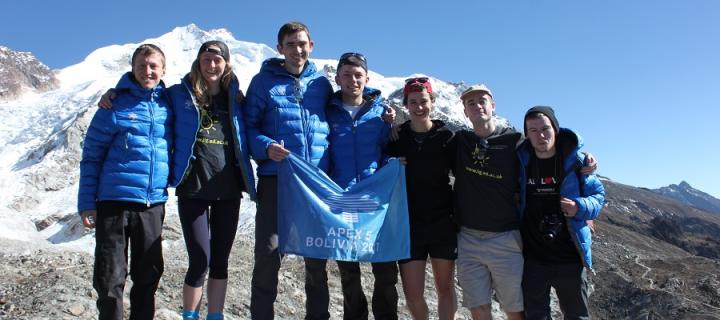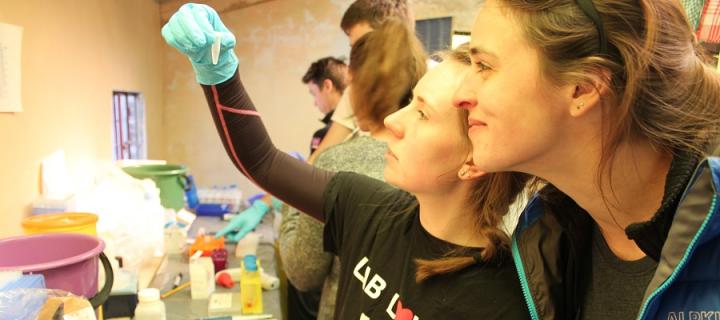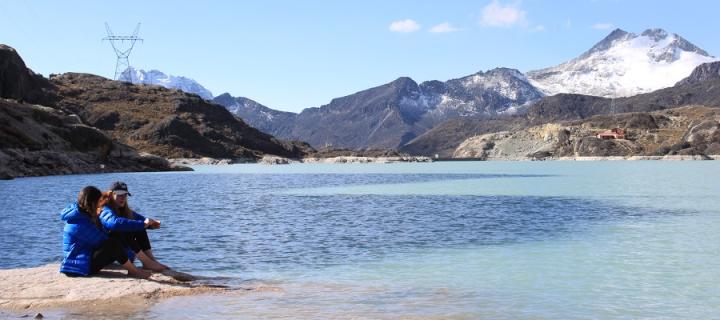Team blog: High altitude research in Bolivia, June 2017.
A group of medical students who comprise the organising team behind the Apex 5 expedition are just back in the UK. They share with us their experiences of project from planning in Edinburgh to on the ground research in Huayna Potosi.

Edinburgh’s Apex (Altitude Physiology Expeditions) is an organisation committed to investigating the effects of hypoxia (low oxygen) on the human body. Entirely led by medical students, the first expedition took place in 2001 with a further four expeditions investigating diverse aspects of human physiology.
APEX 5 was born in 2014 when Ellie Lee, Chris Graham, Gordon Paterson and Jason Young were inspired as research participants on the APEX 4 expedition. After teaming up with Becky Dru and Greig Torpey, we began to plan our own high altitude adventure. The last three years have been filled with many highs, some lows, new friendships, and many learning experiences!
The research
Why high altitude research? Critically, high altitude environments allow us to study the effects of hypoxia on the human body, where oxygen concentrations are markedly lower than at sea level. Research conducted in a high altitude environment allows the effect of hypoxia to be examined in relative isolation; thus, high altitude research can be related to millions of hypoxic patients worldwide.

Our research consisted of many arms investigating human physiology, including neutrophil memory, platelet reactivity, cognitive performance, and macular function. We also had a psychological arm, investigating the link between personalities and acute mountain sickness. Post-expedition, we are now in the process of interpreting our results – watch this space!
A busy 2017
Competition was fierce, as we only had 30 places for University of Edinburgh students to join us as our research participants. We interviewed around 80, and were delighted with the team we selected!
We had a lot to juggle alongside our medical studies – with regular team meetings, ethical documentation, grant applications, securing sponsorship, publicity, organising in-country logistics, booking flights, organising blood sample shipment, establishing a partnership with a local laboratory… the list goes on!
A key part of our pre-expedition preparation was undertaking baseline testing at the Queen’s Medical Research Institute. This allowed us to gather baseline data which could be compared to later high altitude data.
The expedition
Straight after summer exams, we flew out to La Paz. As volunteers explored the city, the organising committee faced an unexpected challenge: nieve (snow, and lots of it!). The road to Chacaltaya was blanketed with snow; we hired a bulldozer to clear the path. However, despite our best efforts, thick ice made clearance impossible. This looked like the end of the expedition - road access was essential for rapid descent in case of high altitude illness. Thankfully, we rallied to find a cosier, safer base on nearby Huayna Potosi mountain.
Our new location required an ad-hoc approach, given the short notice! We fashioned a lab bench out of old drum barrels and wood, and re-routed electricity cables to set up our pop-up lab at about 4,800m. Our first day on the mountain was full on: we undertook all research projects including blood sampling and eye testing on this day.

Aside from our research objectives, we aimed to foster a scientific interest amongst our volunteers. Every volunteer was offered a half day “lab internship” with Jason, Joe and Gordon, where they could hone their skills and ask their own questions about the projects. Research was not all that was on offer, however. On days off, we had time to explore the beautiful surroundings - a highlight being the Huayna Potosi glacier.
At the end of the expedition, we returned to La Paz to celebrate our achievement over curry, emotional speeches, drinks, and a boogie.
We are now writing up expedition reports and analysing our research for presentation and publication. We look forward to sharing our results widely, which we hope will inspire other students to get involved with research.
We look forward to passing on the baton too, as we help guide whoever takes on the challenge of APEX 6…
Support
This expedition would not have been possible without the incredible support of Drs Kenneth Baillie and Roger Thompson, who established Apex in 2000. We are very grateful also to Professor Moira Whyte and Dr Fanney Kristmundsdottir in the Medical School for all of their support, as well as Professor Sir Timothy O’Shea and the Innovative Initiative Grants from the University. Not to mention our many sponsors and supporters - too many to thank here!
From negotiating in Spanish one minute, to distributing tasks amongst the organising committee the next, meanwhile overseeing a day of research testing – there was never a dull moment, nor one we didn’t learn from. I can’t thank the rest of the APEX 5 team enough for the experience and memories.
Related links
Visit the Apex 5 blog to find out more about activities in Bolivia

